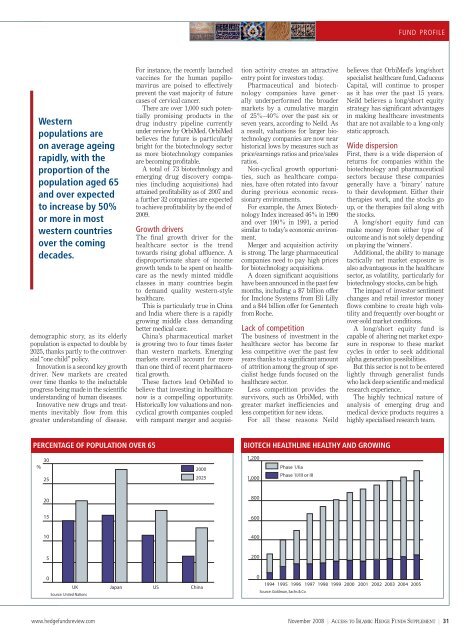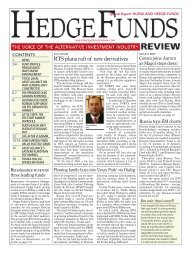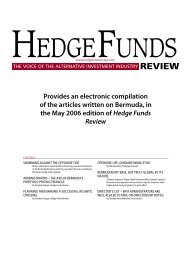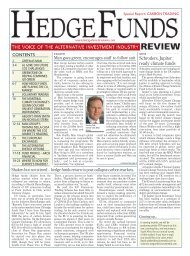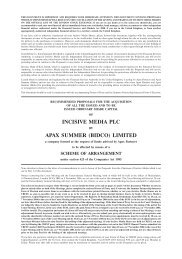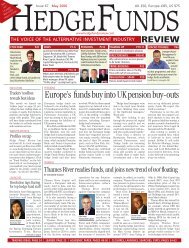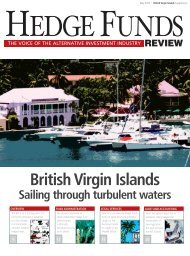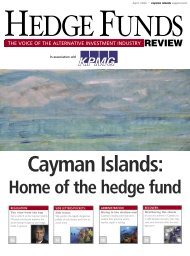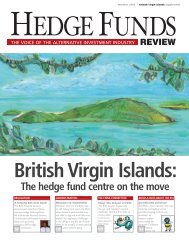Access to Islamic Hedge Funds - Incisive Media
Access to Islamic Hedge Funds - Incisive Media
Access to Islamic Hedge Funds - Incisive Media
You also want an ePaper? Increase the reach of your titles
YUMPU automatically turns print PDFs into web optimized ePapers that Google loves.
fund profile<br />
Western<br />
populations are<br />
on average ageing<br />
rapidly, with the<br />
proportion of the<br />
population aged 65<br />
and over expected<br />
<strong>to</strong> increase by 50%<br />
or more in most<br />
western countries<br />
over the coming<br />
decades.<br />
demographic s<strong>to</strong>ry, as its elderly<br />
population is expected <strong>to</strong> double by<br />
2025, thanks partly <strong>to</strong> the controversial<br />
“one child” policy.<br />
Innovation is a second key growth<br />
driver. New markets are created<br />
over time thanks <strong>to</strong> the ineluctable<br />
progress being made in the scientific<br />
understanding of human diseases.<br />
Innovative new drugs and treatments<br />
inevitably flow from this<br />
greater understanding of disease.<br />
For instance, the recently launched<br />
vaccines for the human papillomavirus<br />
are poised <strong>to</strong> effectively<br />
prevent the vast majority of future<br />
cases of cervical cancer.<br />
There are over 1,000 such potentially<br />
promising products in the<br />
drug industry pipeline currently<br />
under review by OrbiMed. OrbiMed<br />
believes the future is particularly<br />
bright for the biotechnology sec<strong>to</strong>r<br />
as more biotechnology companies<br />
are becoming profitable.<br />
A <strong>to</strong>tal of 73 biotechnology and<br />
emerging drug discovery companies<br />
(including acquisitions) had<br />
attained profitability as of 2007 and<br />
a further 32 companies are expected<br />
<strong>to</strong> achieve profitability by the end of<br />
2009.<br />
Growth drivers<br />
The final growth driver for the<br />
healthcare sec<strong>to</strong>r is the trend<br />
<strong>to</strong>wards rising global affluence. A<br />
disproportionate share of income<br />
growth tends <strong>to</strong> be spent on healthcare<br />
as the newly minted middle<br />
classes in many countries begin<br />
<strong>to</strong> demand quality western-style<br />
healthcare.<br />
This is particularly true in China<br />
and India where there is a rapidly<br />
growing middle class demanding<br />
better medical care.<br />
China’s pharmaceutical market<br />
is growing two <strong>to</strong> four times faster<br />
than western markets. Emerging<br />
markets overall account for more<br />
than one third of recent pharmaceutical<br />
growth.<br />
These fac<strong>to</strong>rs lead OrbiMed <strong>to</strong><br />
believe that investing in healthcare<br />
now is a compelling opportunity.<br />
His<strong>to</strong>rically low valuations and noncyclical<br />
growth companies coupled<br />
with rampant merger and acquisition<br />
activity creates an attractive<br />
entry point for inves<strong>to</strong>rs <strong>to</strong>day.<br />
Pharmaceutical and biotechnology<br />
companies have generally<br />
underperformed the broader<br />
markets by a cumulative margin<br />
of 25%–40% over the past six or<br />
seven years, according <strong>to</strong> Neild. As<br />
a result, valuations for larger biotechnology<br />
companies are now near<br />
his<strong>to</strong>rical lows by measures such as<br />
price/earnings ratios and price/sales<br />
ratios.<br />
Non-cyclical growth opportunities,<br />
such as healthcare companies,<br />
have often rotated in<strong>to</strong> favour<br />
during previous economic recessionary<br />
environments.<br />
For example, the Amex Biotechnology<br />
Index increased 46% in 1990<br />
and over 190% in 1991, a period<br />
similar <strong>to</strong> <strong>to</strong>day’s economic environment.<br />
Merger and acquisition activity<br />
is strong. The large pharmaceutical<br />
companies need <strong>to</strong> pay high prices<br />
for biotechnology acquisitions.<br />
A dozen significant acquisitions<br />
have been announced in the past few<br />
months, including a $7 billion offer<br />
for Imclone Systems from Eli Lilly<br />
and a $44 billion offer for Genentech<br />
from Roche.<br />
Lack of competition<br />
The business of investment in the<br />
healthcare sec<strong>to</strong>r has become far<br />
less competitive over the past few<br />
years thanks <strong>to</strong> a significant amount<br />
of attrition among the group of specialist<br />
hedge funds focused on the<br />
healthcare sec<strong>to</strong>r.<br />
Less competition provides the<br />
survivors, such as OrbiMed, with<br />
greater market inefficiencies and<br />
less competition for new ideas.<br />
For all these reasons Neild<br />
believes that OrbiMed’s long/short<br />
specialist healthcare fund, Caduceus<br />
Capital, will continue <strong>to</strong> prosper<br />
as it has over the past 15 years.<br />
Neild believes a long/short equity<br />
strategy has significant advantages<br />
in making healthcare investments<br />
that are not available <strong>to</strong> a long-only<br />
static approach.<br />
Wide dispersion<br />
First, there is a wide dispersion of<br />
returns for companies within the<br />
biotechnology and pharmaceutical<br />
sec<strong>to</strong>rs because these companies<br />
generally have a ‘binary’ nature<br />
<strong>to</strong> their development. Either their<br />
therapies work, and the s<strong>to</strong>cks go<br />
up, or the therapies fail along with<br />
the s<strong>to</strong>cks.<br />
A long/short equity fund can<br />
make money from either type of<br />
outcome and is not solely depending<br />
on playing the ‘winners’.<br />
Additional, the ability <strong>to</strong> manage<br />
tactically net market exposure is<br />
also advantageous in the healthcare<br />
sec<strong>to</strong>r, as volatility, particularly for<br />
biotechnology s<strong>to</strong>cks, can be high.<br />
The impact of inves<strong>to</strong>r sentiment<br />
changes and retail inves<strong>to</strong>r money<br />
flows combine <strong>to</strong> create high volatility<br />
and frequently over-bought or<br />
over-sold market conditions.<br />
A long/short equity fund is<br />
capable of altering net market exposure<br />
in response <strong>to</strong> these market<br />
cycles in order <strong>to</strong> seek additional<br />
alpha generation possibilities.<br />
But this sec<strong>to</strong>r is not <strong>to</strong> be entered<br />
lightly through generalist funds<br />
who lack deep scientific and medical<br />
research experience.<br />
The highly technical nature of<br />
analysis of emerging drug and<br />
medical device products requires a<br />
highly specialised research team.<br />
percentage of population over 65<br />
biotech healthline healthy and growing<br />
30<br />
%<br />
25<br />
2000<br />
2025<br />
1,200<br />
1,000<br />
Phase 1/Iia<br />
Phase 1I/III or III<br />
20<br />
800<br />
15<br />
600<br />
10<br />
400<br />
5<br />
200<br />
0<br />
Source: United Nations<br />
UK Japan US China<br />
0<br />
1994 1995 1996 1997 1998 1999 2000 2001 2002 2003 2004 2005<br />
Source: Goldman, Sachs & Co<br />
www.hedgefundsreview.com November 2008 | <strong>Access</strong> <strong>to</strong> <strong>Islamic</strong> <strong>Hedge</strong> <strong>Funds</strong> Supplement | 31


